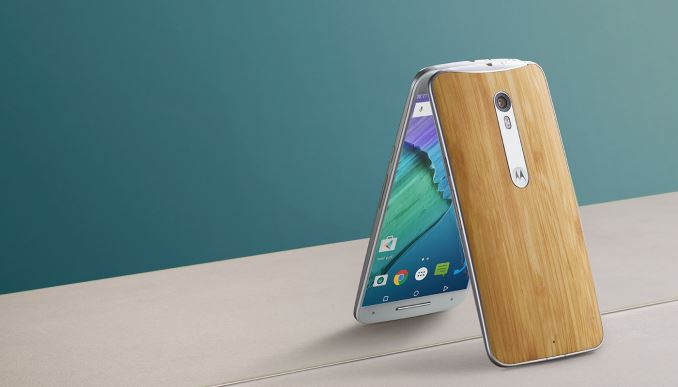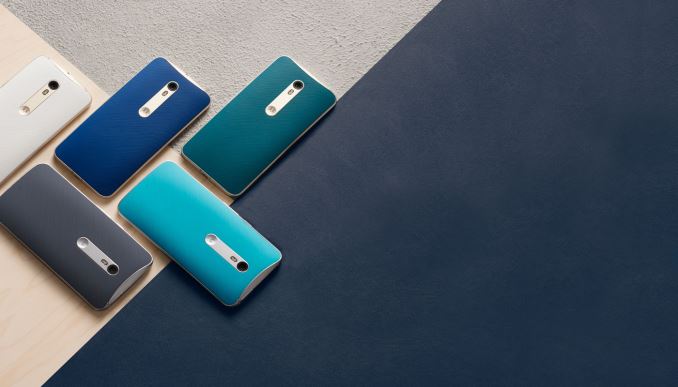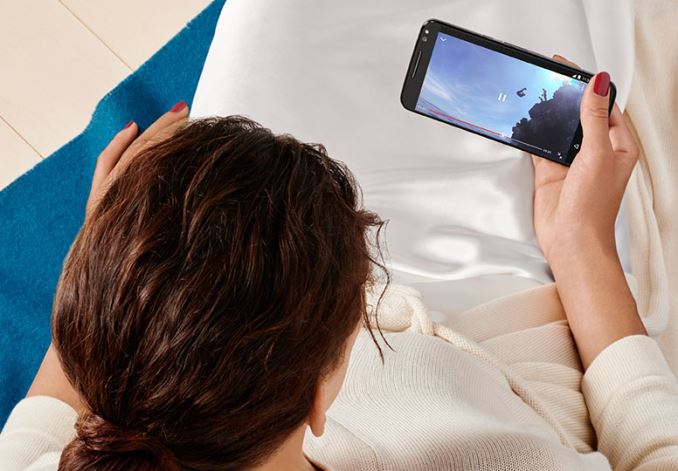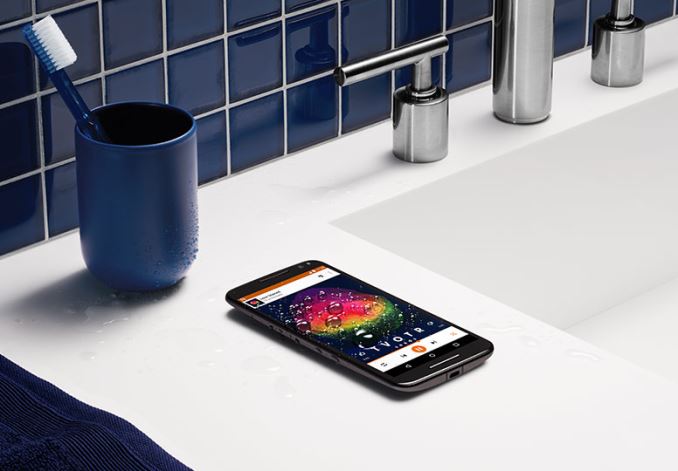Motorola Announces the Moto X Style
by Joshua Ho on July 28, 2015 10:50 AM EST
Today, Motorola also announced their new flagship phone, the Moto X Style. Following the trend of larger screen sizes, it seems Motorola has taken this trend to its logical conclusion by cramming a 5.7” display into the phone, which really places this squarely in the phablet space rather than smartphone space despite the 76% screen to body ratio. The design has also been refreshed for this year to distinguish this device from the previous Moto X if size wasn’t enough of a differentiator. As always, the spec table is below to provide perspective on the changes between each device.
| Moto X (2014) | Moto X Style | |
| SoC | Snapdragon 801 2.5 GHz | Snapdragon 808 1.8/1.44 GHz Cortex A57/A53 |
| RAM | 2GB LPDDR3 | 3GB LPDDR3 |
| NAND | 16/32/64GB NAND | 16/32/64GB NAND + microSD |
| Display | 5.2” 1080p SAMOLED |
5.7” 1440p IPS |
| Network | 2G / 3G / 4G LTE (Category 4 LTE) | 2G / 3G / 4G LTE (Category 6 LTE) |
| Dimensions | 140.8 x 72.4 x 3.8-9.9mm, 144g | 153.9 x 76.2 x 6.1-11.06mm, 179g |
| Camera | 13MP Rear Facing (Sony IMX135) f/2.33, 1.1 micron 1/3.06" sensor | 21MP Rear Facing w/ PDAF f/2.0, 1.1 micron 1/2.4" sensor |
| 2.1MP Front Facing | 5MP Front Facing w/ LED Flash | |
| Battery | 2300 mAh (8.74 Whr) | 3000 mAh (11.4 Whr) |
| OS | Android 4.4 (At Launch) | Android 5.1 (At Launch) |
| Connectivity | 1x1 802.11a/b/g/n/ac + BT 4.0, USB2.0, GPS/GNSS, NFC |
2x2 802.11a/b/g/n/ac + BT 4.1, USB2.0, GPS/GNSS, NFC |
| SIM | NanoSIM | NanoSIM |
Other than the display and the dimensions, one of the most obvious changes is really the camera. Motorola is really focusing on camera this year as a key point of differentiation, going as far as to proclaim that their camera is superior to the iPhone 6 and 6 Plus during their launch event. It seems that their first step to doing this is to equip the Moto X Style with a 21MP camera. Although not stated in the launch event, it isn’t a far leap to guess that this is either OmniVision’s OV21840 or Sony’s IMX230 as both are of similar spec.
At a high level, there are also significant changes to the SoC as we see a bump to Qualcomm’s Snapdragon 808 and a bump in RAM to 3GB to improve multitasking and memory management. It seems that Motorola’s NLP and sensor hub remain, although it isn’t disclosed whether this is still a TI solution for NLP and an STM sensor hub.
The display is also a major shift in Motorola’s component choices, as the 5.7” 1440p display is actually an LCD panel rather than AMOLED, which is what Motorola usually favors with their high-end smartphones. There are also dual front-facing stereo speakers mounted above and below the display, with the extra bezel for display drivers mounted directly below the top speaker to accommodate the on-screen buttons comfortably.
Overall, the Moto X Style is a significant departure from the Moto X (2014), which in turn was a major departure from the Moto X (2013). It remains to be seen whether Motorola’s bet on a phablet-sized phone will pay off, but it certainly could be a major competitor with phablets launching in the near future.
The Moto X Style will be available in September, and will be offered on Motomaker. A Pure Edition that works on all 4 US carriers will be offered for sale unlocked in the US as well. The standard colors will be white and black, with options for customization via Motomaker for leather, wood, and silicone finishes. The price will start 399.99 USD for the Pure Edition.














46 Comments
View All Comments
Impulses - Wednesday, July 29, 2015 - link
They also had a bunch of people clamoring for larger tho, as well as the entire Android market holding up larger phones as a trump card... Plus Most Android phones were smaller to begin with, even after the OG EVO launched at 4.3" it took a few years before we went completely over the edge...It's really been the last two years that every flagship suddenly went 5.5", and they haven't even always done so with the goal of building in larger batteries... Maybe the OG Moto X sold really badly and it scared off the other OEM, who knows...
Shadowmaster625 - Tuesday, July 28, 2015 - link
Why does that girl have a 9 candle birthday cake?babadudu - Wednesday, July 29, 2015 - link
because shes ninexnay - Tuesday, July 28, 2015 - link
Motorola is missing one very important camera feature: optical image stabilization. You can do tricks and gimmicks but it's just needed and crucial in a mobile camera sensor if you want to call it high-end.varad - Tuesday, July 28, 2015 - link
So the iPhone 6 isn't high-end according to you?Impulses - Tuesday, July 28, 2015 - link
The value of OIS can be very relative, depending on what you're actually shooting. If you're shooting people in general it might not help much unless they're all posed shots of very still people, if you slow the shutter speed enough to take advantage of OIS you're just gonna suffer from motion blur... Shooting static scenes at night (two big qualifiers) it will definitely help a lot.Impulses - Tuesday, July 28, 2015 - link
Balancing auto mode so that it doesn't rely on OIS and too-slow shutter speeds is also a fine balance phone makers often get wrong.gg555 - Wednesday, July 29, 2015 - link
I think there is nothing "relative" at all about the value of OIS. It provides huge improvements for low light shots and stability of imaging in video. All the electronic image stablization solutions that claim to be almost as good always turn out to suck in actual practice and just be hype.Does OIS improve every type of shot? No. But no specific camera technology does. It however vastly improves certain types of shots and the handful of truly good phone cameras have had OIS. You just can't claim these days to be focusing on the camera and being flagship quality, without OIS. As opposed to more megapixels and "ultra"pixels, which are just gimmicks, OIS is a real technology with real value.
The only truly great phone camera ever made without OIS was the Nokia 808. But that had a massive 1/1.2 sensors that still eclipses every other phone out there in size (being a good four times larger).
The best thing about the Moto X Style is the 1/2.4 sensors that is more respectable than the lame 1/3 sensors that have been standard for so long (even though that's nine year old technology). But still, it's kind of a joke not to have OIS and claim to be focusing on the camera. Even Samsung is finally using OIS.
Impulses - Thursday, July 30, 2015 - link
I never said OIS wasn't of any value, but it's still relative to the kinda shot you're taking. Simply put, low light shots of people that aren't staying still won't benefit from it, posed shots will to an extent, static shots benefit greatly.Impulses - Thursday, July 30, 2015 - link
And if that isn't clear enough, if you're shooting people in their element you need a shutter speed fast enough that OIS won't even engage at all (way beyond 1/focal length)... Or shouldn't, if it does and the camera relies on it via a slow shutter speed you'll see motion blur, cause people like to move unfortunately. ;)Just saying, it's not the end all solution great low light shots, but i wouldn't expect great low light shots out of a phone one way or the other, relatively speaking!